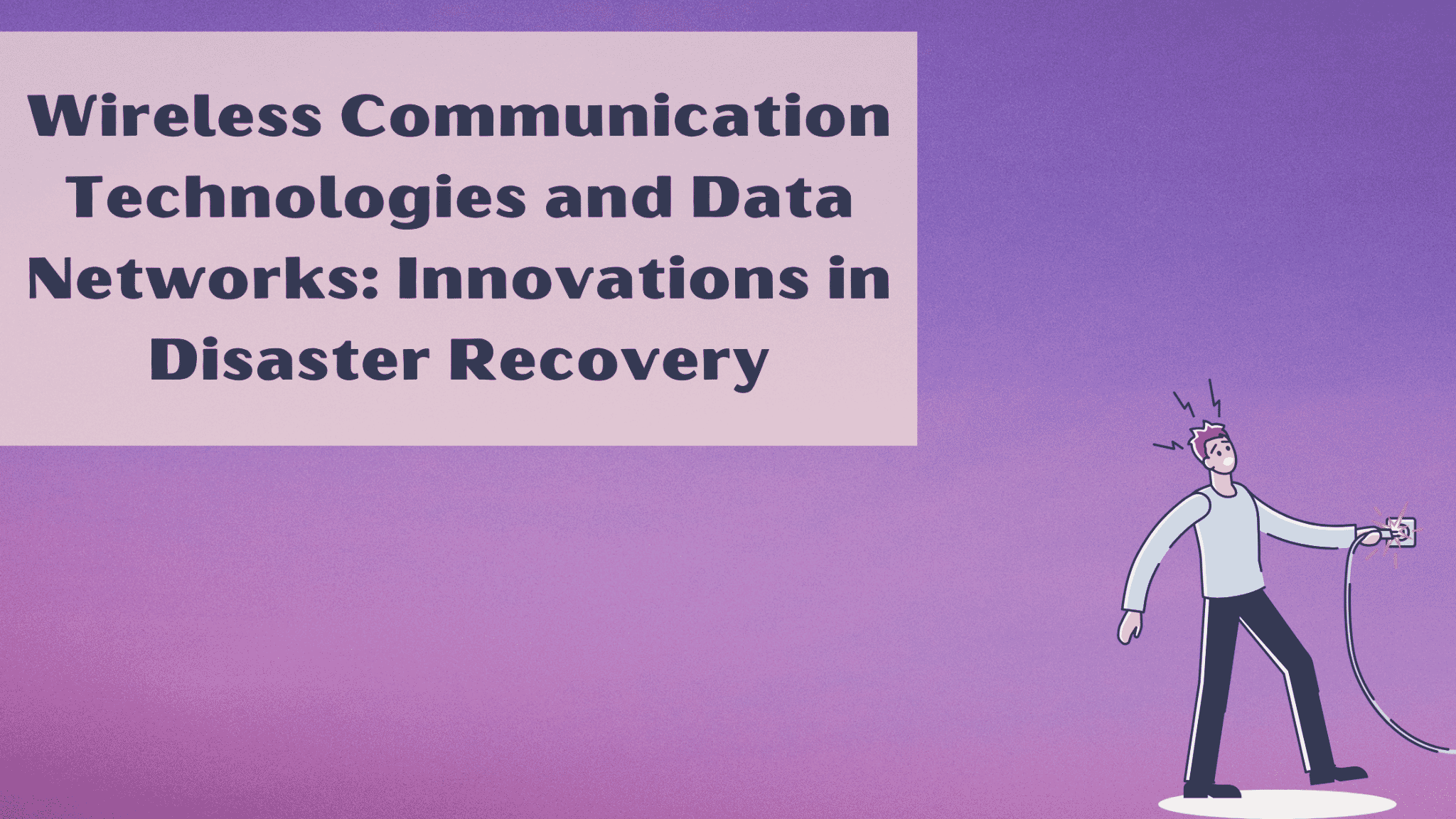Communication is critical during disasters, as it is the only way of enabling coordination between emergency response teams and ensuring continuous delivery of essential services. However, traditional communication infrastructure is vulnerable to damage, highlighting the need for innovative technologies tailored specifically for disaster resilience. As natural disasters grow more extreme with climate change, it is projected that global economic losses will surpass $300 billion annually by 2030.
This underscores the urgency of developing robust wireless communication systems and data networks that can withstand infrastructure damage during crises. In response to this pressing need, advancements in wireless communication technologies and data networks play a pivotal role in enhancing disaster recovery efforts. Implementing resilient and adaptive communication systems ensures that vital information reaches the right channels promptly, facilitating swift decision-making in critical situations.
Contents
Wireless Communication Technologies Enhancing Disaster Recovery

Many businesses in South Florida rely on providers like data network cabling Doral fl for installing and maintaining their data networks.
Having efficient and stable network cabling services is essential for enhancing disaster recovery, and it will serve as a means of sustenance and ensuring their continued survival even after the disaster has struck.
There are various ways in which wireless communication technologies can be useful in enhancing disaster recovery. Businesses looking to transition from wired to wireless networks and are not sure of the right way to go about it can find some enlightenment after reading this section.
Some of the wireless technologies that can serve to enhance disaster recovery are:
Utilization of 5G Technology for Rapid Data Transmission
5G networks, with speeds up to 100 times faster than 4G, have tremendous potential to transform disaster recovery with real-time connectivity and reduced response times during emergencies. According to GSMA, 5G connections will reach 3.6 billion globally by 2025, powered by enhanced mobile broadband and ultra-reliable, low latency capabilities.
For instance, Verizon recently tried 5G for thermal imaging drones used by firefighters and x-ray scanning robots that assess building structural integrity after disasters. Such applications highlight how 5G can enable rapid transmission of potentially life-saving data during crises.
- Additional promising use cases powered by 5G include:
- Real-time high-definition video streaming from disaster sites to guide emergency response
- Augmented reality systems that overlay building schematics onto rescue workers’ field of view
- Wireless sensors that monitor cracks/damage in critical infrastructure
- Self-organizing networks that dynamically optimize capacity/coverage as needs evolve
GSMA forecasts that 5G will account for 20% of global connections by 2025. Its ultra-reliable, low-latency connectivity will be transformative for time-critical emergency coordination.
Integration of Satellite Communication for Resilient Connectivity
Unlike terrestrial infrastructure confined to the ground, satellite communication can provide extensive coverage spanning oceans, airspace, and remote areas—an extremely useful capability during disasters.
For example, emergency teams relied extensively on satellite networks when Hurricane Maria disabled 97% of Puerto Rico’s cell towers in 2017. Iridium’s satellite constellation alone provided connectivity for over 40 disaster relief aircraft, and 120 ground terminals, and fielded calls from over 600 satellite phones during Hurricane Maria recovery efforts.
Looking ahead, the satellite industry expects ballooning demand growth between 50-100% over the next 5-7 years according to the Satellite Industry Association (SIA), partly driven by investments in integrated satellite-5G networks. These networks blend the extensive coverage of satellite systems with 5G’s high speeds, enabling resilient communication.
Data Networks: Backbone of Resilient Disaster Recovery
Implementation of Mesh Networks for Decentralized Communication
Unlike conventional networks with centralized infrastructure, mesh networks have a decentralized architecture where each node dynamically connects with adjacent nodes. This built-in redundancy enables real-time local communication even when nodes or transmission pathways are damaged (Source: Cisco).
Mesh networks are thus extremely resilient, and capable of automatically rerouting data via alternative pathways when disaster conditions disrupt nodes or block certain transmission routes. Cities in disaster-prone regions like New Orleans have deployed mesh networks resilient to infrastructure damage from recurrent floods and hurricanes.
Adoption of Software-Defined Networking (SDN) for Dynamic Network Management
SDN consolidates network control functions into a centralized controller, granting administrators granular control over traffic routing and bandwidth allocation across the network (Source: IDC). These capabilities enable real-time adjustments to prioritize critical applications and temporarily increase capacity for emergency services as needs evolve during disasters.
A 2022 survey found that 60% of communication service providers have now adopted SDN, citing substantial improvements in network flexibility, visibility, automation, and resilience against outages during events like wildfires and earthquakes (Source: Network World).
Innovative Solutions and Case Studies
Drone-Based Communication Systems
Drones equipped with communication technology like Wi-Fi hotspots, long-range radios, or cellular base stations can provide aerial connectivity when local infrastructure is damaged. Drones have assisted emergency teams with aerial damage assessments, distribution of emergency supplies, and location of survivors needing evacuation in disasters globally.
Rapidly deployable drone networks also show promise for temporary communication during the onset phases of disasters before dedicated infrastructure can be set up. Facebook recently tested high-altitude internet drones and floating balloons to provide internet connectivity after Puerto Rico’s cellular network was paralyzed for months following Hurricane Maria.
Mobile Command Centers Equipped with Advanced Communication Technologies
To coordinate emergency response across multiple agencies, the Department of Homeland Security has deployed state-of-the-art mobile command centers equipped with interoperable communication systems including secure Wi-Fi, 4G/LTE, and satellite connectivity resistant to network disruptions. These enable unified command between agencies confronted with infrastructure damage after disasters.
Such mobile command posts, deployable within hours to disaster sites, provide resilient communication hubs for responding agencies. They enable vital data sharing, video conferencing, and mapping/GPS guidance using in-house wireless networks immune to local infrastructure outages.
Conclusion
Communication is indispensable for effective emergency response during disasters when being able to rapidly share information and coordinate across teams can save lives. However, traditional infrastructure is prone to damage posing grave risks of communication blackouts during disasters. Cutting-edge wireless technologies and resilient data networks that leverage innovative architectural frameworks attuned for reliability during infrastructure disruption are overcoming these barriers.
As natural disasters escalate in frequency and severity driven by climate change, a new generation of robust, rapidly deployable communication systems leveraging principles of decentralization, flexibility, and built-in redundancy will be essential for minimizing socio-economic losses. Government and industry stakeholders must prioritize policies and investments in disaster-resilient communication infrastructure to ensure future preparedness.
Frequently Asked Questions (FAQs)
How Do Wireless Communication Technologies Withstand Infrastructure Damage During Disasters?
Wireless communication technologies specially designed for resilient transmission including mesh networks and 5G leverage built-in redundancy through dynamic multi-path routing capabilities resistant to damage of nodes or transmission routes. Satellite communication similarly overcomes local infrastructure damage by covering affected areas remotely from space.
What Measures Are in Place to Ensure the Security and Reliability of Data Networks in Crisis Situations?
The security, speed, and reliability of data networks during disasters are critical given they coordinate emergency response and essential services. Resilient system architecture leveraging principles such as decentralization, redundancy, and flexibility enables continued functionality when disaster damage occurs. Agile network management frameworks like SDN also facilitate traffic prioritization and real-time capacity adjustments attuned to evolving needs.
Are There Any Regulatory Frameworks governing the Use of Innovative Communication Technologies in Disaster Recovery Efforts?
Yes, government agencies have established dedicated regulatory frameworks and funding programs governing disaster communication systems. For instance, in the U.S. the FCC manages a $400 million ReConnect loan program to support the deployment of communication infrastructure in rural areas vulnerable to disasters. Such policies aim to accelerate the development, adoption & interoperability of innovative technologies tailored for crisis scenarios.
Also Read:
- How to Change Twitch Name Color in Chats & More Tips
- Effective Ways To Improve Your SEO With Heatmaps
- Java Print vs Println – What’s The Difference?
- How to Use Discord in Full-Screen Mode(Web & Application)
- Printf vs cout: What is the difference?
